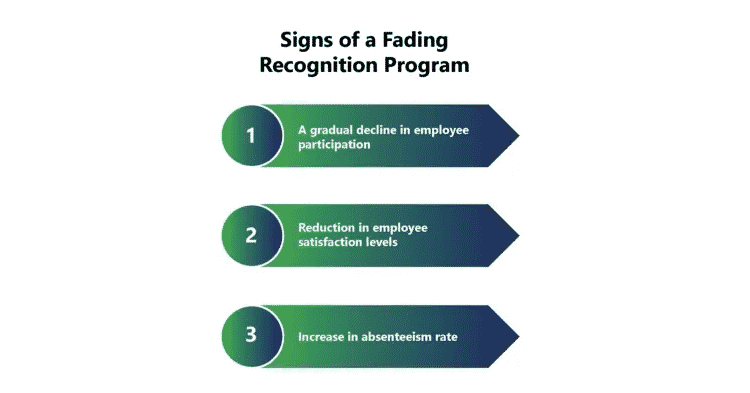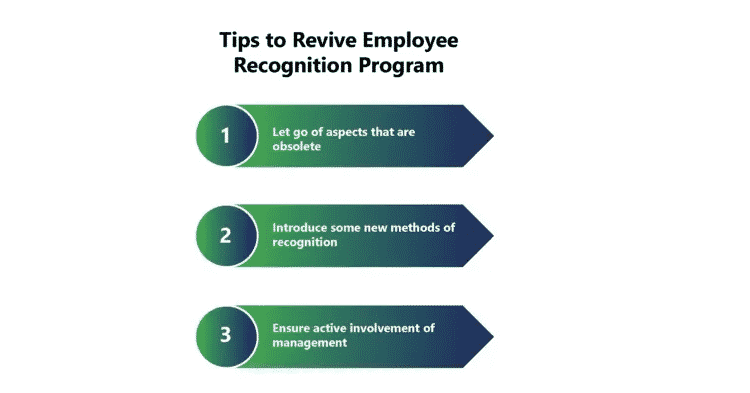1. Identify Signs of Decline: Watch for declining employee participation, reduced satisfaction, and increased absenteeism as indicators of a fading recognition program.
2 Remove Obsolete Elements: Based on employee feedback, replace outdated aspects of the program with more engaging and relevant options to reignite interest.
3. Introduce New Practices: To maintain excitement and involvement, regularly introduce new and creative rewards that align with changing employee needs.
4. Ensure Management Involvement: Actively involve management in the recognition process to demonstrate commitment and motivate employees.
Many organizations fail to sustain the level of employee participation in their employee rewards and recognition programs. This results in even the best employee rewards programs gradually fading into obscurity. This article examines how to revive a fading employee recognition program.
Most organizations fail to recognize the early signs that might indicate the commencement of the downfall of their recognition programs.
They ignore these signs as a passing phase and do not take timely corrective actions.
So, to avoid such situations, organizations should pay attention to any signs of decreasing employee interest in recognition programs.
These are the top 4 signs:


One of the earliest indicators of a fading employee recognition program is a gradual decline in employee participation.
This can be due to repeated rewards, a lack of variety, poorly designed policies, a lack of interest from management, and other factors.
Hence, organizations need to gather more information about factors and find ways to rectify them.

When there is a sudden increase in dissatisfied employees, organizations should take it as a warning sign.
Hence, they should try understanding employees’ unhappiness with the recognition program.
They should interact one-on-one with such employees to better understand the reasons for their disappointment.

If more employees take leave for frivolous reasons, management should consider this an indication of a fading program.
Employees skipping office frequently may be because they do not care much about the organization’s success.
Hence, managers are responsible for interacting with such employees to understand the reasons for this behavior.
Acknowledging that their employee recognition program is fading is the first and the most crucial step towards reviving it.
The next step is to identify the strategies to get the program back on track.
So, here are a few such strategies:


Based on employee feedback, the organization should list aspects of the program that have become redundant.
Obsolete parts of the program should be replaced with more interesting and creative options that also find favor with the employees.
For example, if the organization has been giving gift vouchers for some time, it may consider options such as extended leave or conveyance benefits.

Also, introducing new rewards regularly is a great way to maintain the recognition program’s novelty and excitement.
Apart from incorporating the changing needs of the employees, new awards can help in reviving their interest in the program.
Organizations can even seek suggestions from the workforce members about the new awards they want to be introduced.

Often, the fading of a recognition program is due to the management’s lack of interest.
The management must continue to take an active part in the recognition program.
Their involvement ensures employees are valued by people who matter the most and keep motivating them.
Reviving an ailing recognition program can be quite challenging, but when handled in a planned way, it can deliver the benefits and the return on investments for which it was designed.

Lead author: Sagar Chaudhuri, the Co-Founder and CEO of HiFives. He is an HR Tech Evangelist with over 25 years of corporate and entrepreneurship experience. In the past, Sagar has worked in leadership roles with companies such as Genpact, Infosys, and ICICI Bank. He has an engineering degree from IIT Kharagpur and an MBA from IIM Lucknow. Connect on LinkedIn
To stay updated on the latest HiFives blogs, follow us on Twitter (@MyHiFives)